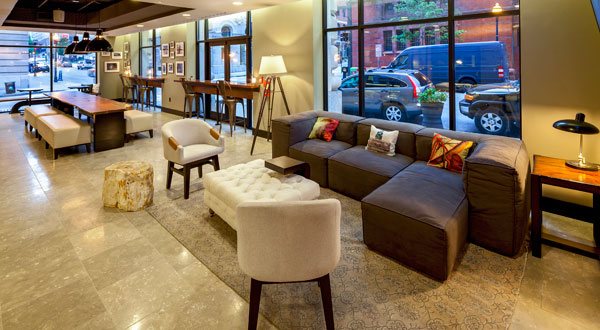








Nearly everyone has seen commercials for Amazon’s Echo. And most will admit they’re impressive. With the use of a simple “wake word”—“Alexa”—the voice-activated digital assistant can order pizza, turn on your lights, and play music, and many other conveniences. Launched in the United States in June 2015, Echo has since become commonplace, popping up in homes all over the world. The device currently has more than 55,000 customer reviews on Amazon, many of them raving about how useful it is and how users can’t remember their lives before it.
The rise of the Echo and voice-recognition technology is just one example of the lightning-fast way technology is evolving and changing people’s lives. Just three years ago, it would have seemed crazy to simply say out loud that you want the lights turned on and have it happen. Today, getting up to flip a switch seems outdated.
As more and more people incorporate these technologies into their homes, it becomes imperative that hoteliers start looking to do the same at their properties. Guests want to be able to access all the amenities and conveniences of home when they’re on the road, and if a property isn’t able to keep up, it will likely be left behind.
The hotel industry is well aware of this possibility, which is why the big brands are innovating like crazy to maintain an edge over smaller, more nimble lodging industry disruptors. By taking a proactive approach to new technology, brands are able to keep ahead of trends and implement solutions before guests even know what it is, exactly, that they’re looking for.
And, when new technology hits hotels, it must be seamless. Keith Cline, president and CEO of La Quinta Holdings, Inc., says that implementing new technology in the hotel space cannot disrupt the guest experience. The best way to ensure that this happens, he says, is to have a technology team in place that understands the needs of the guests and the overall hospitality experience. “The pace is very fast and all of us are clamoring to stay competitive and meet guest expectations. To do this, we really have to have a mechanism to drive technological innovations from within,” he explains. “We also have to be able to coordinate all of our teams, from operations to HR, and take a cross-functional approach. That’s impossible if we try to tackle technology piecemeal.”
Tech Trends
With new tech hitting the hotel industry so rapidly, taking the time to examine the main trends to best direct focus can be extremely valuable. Just a few of the trends the big brands have been watching very closely over the past few years include innovating the booking experience, mobile apps, streaming services, and the previously mentioned voice recognition. And, while these technologies are all quite different, they also have a very strong thread tying them all together—the guest experience.
“Emerging technology has fundamentally impacted the industry in terms of accessibility,” Jonathan Wilson, vice president of product innovation and brand services at Hilton Worldwide, says. “And that’s not just hoteliers’ access to guests, but also guests’ access to hotels. Guests are now able to interact with your property long before they ever set foot in the building.” Between an official brand website, OTAs like Expedia and Booking.com, online review sites like TripAdvisor, and, of course, social media accounts, guests can get to know a hotel very well before they even book a room.
Cline concurs, and notes that a lot of the new technology entering the hotel space is centered on the pre-stay experience. “Brands need to be focused on increasing the acquisition of new customers via improved search mechanisms and easier booking experiences, things that third-party booking engines and OTAs have been focused on for years,” he says. Cline adds that all of the major hotel brands are working to tackle this problem. “I think we’ve all collectively invested literally billions of dollars in this area over the past several years, and if you look at the availability of technology today, there are a lot of good options. They’re all pretty affordable, they’re all scalable, and they all offer high performance.”
There are a huge number of technologies out there that help hoteliers achieve a better pre-stay experience, and today they are more easily accessible than they ever have been in the past. John Edwards, chief information officer at Red Lion Hotels Corporation (RLHC), says that there has been a shift away from closed and proprietary systems, and hoteliers are shopping around to procure the ideal mix of software and hardware to deliver the best guest experience. “Vendors have developed an appetite for customizing existing technology solutions to better fit the hotel market, as well as making them compatible with existing hardware systems. There has also been a move towards cloud connectivity and the integration of systems that previously would have been separate,” he says.
Using these third-party vendors can have a massive impact on a company’s ability to incorporate new technology on a consistent basis. “Using an incredibly qualified company with a scalable platform means you don’t have to pull internal resources away from other initiatives,” describes Cline. “Therefore, your team remains focused on managing that partner and driving innovation, which is really what’s important.”
Hotel RL BaltimoreEdwards also notes that there’s a lot of conversation around machine learning and data analytics. “So much of the technology we use today is aggregating data, and learning from that data and making it actionable is changing the ways that businesses operate,” he says.
Cline, too, is fascinated by artificial intelligence. “It’s going to be very interesting to see how this technology affects conversion in call center applications. It will be able to do things like combine the right agent with the right customer to improve the likelihood of booking,” he notes.
Other trends include the domination of cloud connectivity, which has become the rule rather than the exception. La Quinta was ahead of the curve in this respect, having moved its property management system (PMS) to a private cloud network 10 years ago in 2007. “Back then, it allowed us to deploy PMS initiatives quickly and easily. Even now, we’re aggressively moving a lot of other applications to the cloud to leverage its benefits. That kind of an ecosystem really affords our technology team the foundation they need to focus on deploying solutions that improve our business rather than worrying about infrastructure,” says Cline.
Another trend driving hotel technology recognizes that guests are traveling with more devices than ever before—not just laptop computers, smart phones, and tablets, but also wearables like Google Glass, Fitbits, and Apple Watches. Optimizing guests’ connectivity should be on all of the major hotel companies’ radars. “When visiting your hotel, guests aren’t just hanging out in their rooms. They’re sitting in the lobby and going to meetings. They need to be able to connect their devices no matter where they are in your hotel,” Edwards says.
Make It Work
So, how do these big hotel companies implement innovations that, by definition, are disruptive to existing processes, while still providing the best guest experience? It’s apparently a combination of deep research, careful preparation, and closely monitored pilot programs.
In the initial steps, hotel company technology teams look to other industries to see which ideas and innovations are taking off, and which are falling flat. They also look to consumer technology. “As an industry, we have to respond to how consumers are living their lives,” Cline says. “For example, there are TVs everywhere in my house, yet no one is watching the broadcast channels. They’re streaming content from their mobile devices and laptops to the big screen. So why wouldn’t hotel guests want the same option?” Right now, La Quinta is one of many brands piloting programs that allow guests to wirelessly cast from their mobile devices or use the same streaming accounts that they use at home.

La Quinta tests new tech at properties like the La Quinta Inn & Suites Morgan Hill-San Jose South.
From these initial planning stages, the companies research existing options and develop a concrete plan for integrating new technology into their properties. Amanda Marcello, vice president, food and beverage at RLHC, oversees many pilot programs. “We tend to roll initiatives out in phases,” she says. “Phase one is by far the longest part of the process. In this phase, we set up the program and integrate it into our existing systems. Setting up, we find, takes a lot of hands, a lot of eyes, and a lot of time. We don’t rush, because ultimately, if it’s built wrong from the beginning, the next phases will not yield the results we’re looking for.” While the majority of RLHC’s hotels are franchised, the company does own a small percentage of its portfolio. It is in these hotels that the majority of pilot programs occur.
Hilton also develops many pilot programs. “We have about 30 pilots going at any given time,” says Wilson. While many of the major hotel brands have a number of properties in which they test out technology and operational systems, Hilton is somewhat unique in that it relies very heavily on what Wilson calls its “innovation hotel,” the Hilton McLean Tysons Corner. Located on the company’s campus in McLean, Va., this is where new technology is tested. “When we put technology in that space, it’s done in a way in which guests, team members, and owners can interact with it in real time. They may love it, they may hate it, they may accidentally break it, but they always give us useful information. Here, we are able to develop programs our owners can use, as opposed to an idea of something they can use,” Wilson says.
The McLean property is also unique in that everyone in the hotel—including the guests—knows when pilot programs are happening. “We’re very transparent about what we’re testing and why we’re testing it. Everyone is engaged in the test, and that includes guests, team members, management, and ownership. This helps ensure that the program gets the most comprehensive feedback possible, allowing Hilton’s tech team to make changes before testing in a broader sample.
Conversely, La Quinta will often test their new program on a much larger scale. “The fact that we own more than 300 of our hotels gives us an interesting advantage when testing new technology,” Cline explains. “We have the flexibility to try something out in a number of properties simultaneously before rolling it out as a brand standard.” However, Cline notes, when piloting something new, La Quinta will often ask franchised properties to participate in the program as well. “Our franchise partners are an important part of driving innovation, and we like to make sure that they’re involved along the way. It keeps everyone engaged with our processes.”
While all brands pilot programs in different ways, they’re all aiming for the same outcome—seamless integration of the technology. Brands work tirelessly to ensure team members are onboard and ready to manage whatever new responsibilities are coming with the technology. “When you’re in charge of technology programs at a larger company, like all of the major hotel brands, you really want to have a dialog with your team and give people from every area of your organization an opportunity to question a program and point out issues that would fly under your radar. When everyone works together, we can build programs that work a lot better in the end,” Marcello describes.
And, though they may not be as nimble as a startup because they must consider the input of a much larger group of people, the infrastructure of big brands offers more stability and safety when implementing new technology. Every technology team considers factors like security and long-term feasibility when developing a program. Cline says that because technology today collects so much personal information and data from its users, protecting guest information is paramount in technology initiatives. “It’s just critical. In La Quinta’s case, we invest heavily in security function to ensure we have the right team, the right infrastructure, and the ability to stay on top of the current trends. It’s part of the ethos of our business.”
Guest Experience
With all of the ingenious technology and gadgets out there today, it can be easy to get carried away. The big brands, while constantly innovating, are still fixated on one goal—giving guests the best experience possible. “Our primary focus when delivering technology is making sure it also aligns with our strategic initiatives, including driving consistency in delivering an outstanding guest experience,” Cline says.

Hotel RL Baltimore is just one property where Red Lion Hotels Corporation pilots new technology programs.
For example, a core piece of RLHC’s technology strategy involves finding ways to enhance the customer experience without unnecessary touch points for the guests. Enter the company’s Beacon program, which uses aggregate data about guests to intuit their needs during their stay. WiFi hotspots throughout the hotel can connect with a guest’s RLHC’s Hello Rewards app and relay information about that guest as he or she moves throughout the hotel. “Imagine, a Hello Rewards member walks up to the hotel’s coffee shop and the barista is automatically notified that this guest is named Sarah and Sarah enjoys lattes with almond milk. Sarah doesn’t need to relay that information, and it gives staff an opportunity to thank our rewards members for their loyalty. And, the guest doesn’t have to do a thing,” adds Marcello.
Big hotel brands are also using technology to improve guest reward programs. For example, La Quinta Returns members can redeem points via text messaging for everyday purchases like groceries. Cline says that by making the program—called Redeem Away—text message-based, it gave La Quinta another opportunity to interact with guests and engage them with their brand.
That interaction is key, because no matter how cool new technology may be, hotels are in the hospitality industry. Connecting with guests on a human level is integral to their overall satisfaction with their stay. If a front desk agent is using the best software on the market, but doesn’t make eye contact and smile at a guest as she’s checking in, what will the guest’s impression be?
Racing Ahead
As technology continues to advance, hotel companies must race to keep up with new innovations. “There’s one thing I can guarantee,” says Cline. “Things will never move any slower than they do today. The future will only move faster. We just have to be ready.”
Copyright 2006-2025 Shanghai Sinoexpo Informa Markets International Exhibition Co., Ltd. All rights reserved